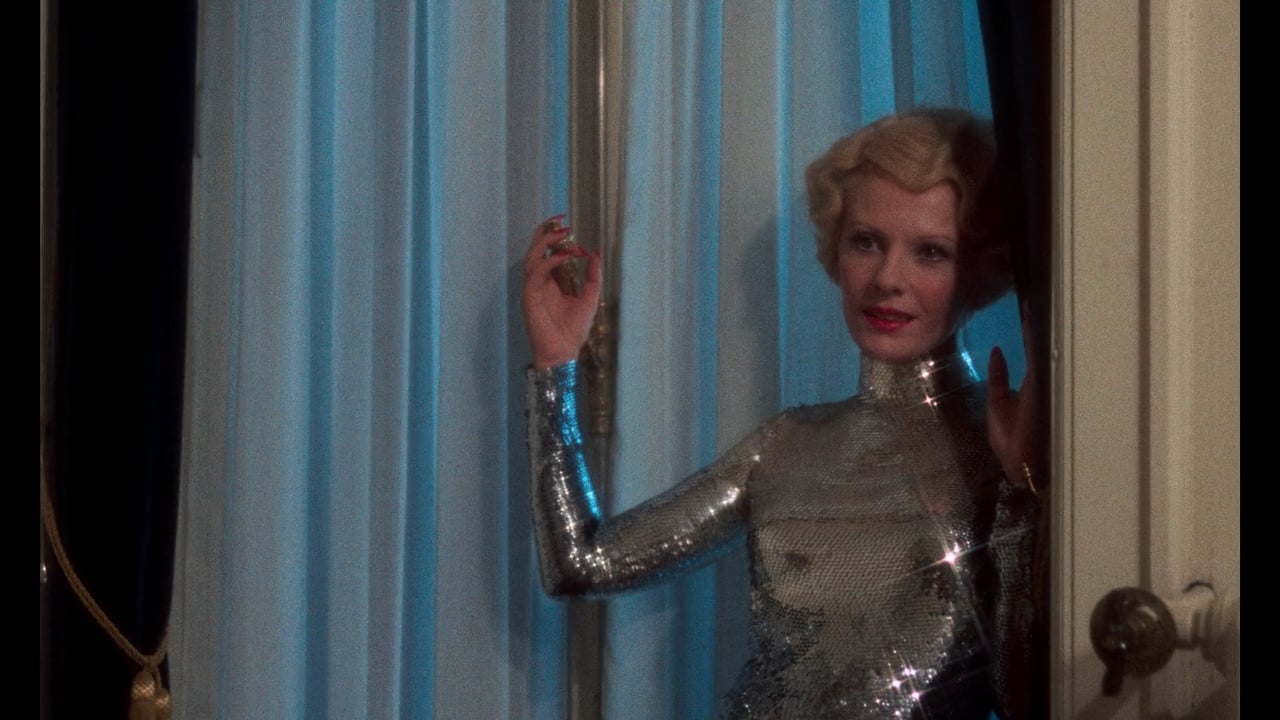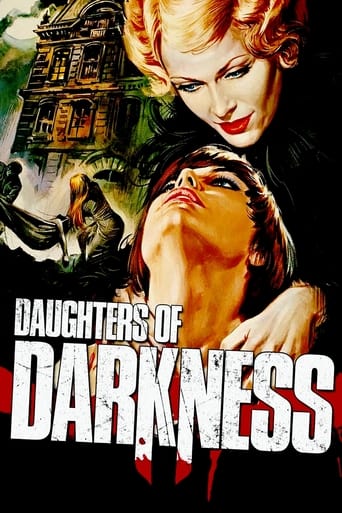

This movie might be the epitome of "mixed bag". Lush production, beautifully photographed, sexy girls, adequate acting,, creepy locations, a decent premise. All the elements for a really fantastic vampire film are here but somehow the film fails to hang together. I put the blame on the script which introduces some really interesting elements but never really does anything with them. At one point the film looks like its going to introduce a sort of murder mystery or suspense type plot when the character of a retired detective is introduced, but he is quickly forgotten. There are hints of John Karlen's strange sexual proclivities but they never amount to anything. The movie does not try to be scary, but never really manages to be atmospheric or creepy either. Despite the perfect setting (the newlyweds are trapped in a deserted hotel in a deserted resort town) you never feel an air of menace or claustrophobia. Seyrig does a passable job, but never really feels menacing or threatening at all. There are some sex scenes which never quite cross the line into erotica but are not really exploitation either. I think the director was trying to go for a "Martin" vibe where you are never quite sure if something supernatural is going on or not. The problem is its so poorly executed it just comes off as boring and nonsensical. I feel this film actually could be a great candidate for a remake, although a lot of what charm it does have comes from early 70s nostalgia. I would really love to see what a better screenwriter and director would be able to do with the same premise.Fans of Giallo may enjoy this simply for the lush productions, locations, and a few weird sleazy scenes, but it is probably not lurid or sleazy enough to satisfy hardcore giallo fans either.
... View MoreNegative! Complete failure, pile of crap film. Successful as an "ART" film, if deaf and blind. Boring, Amateur Acting, Garbage Story.OK, first rule of a film, should probably be is ENTERTAINMENT. This movie is boring, slow, amateur acting all around, amateur directing, the story is just plain garbage. Best part is the cinematography, that was good. The editing sucked, you can tell by how long they linger on a frame. And all the cuts of the waves crashing in. The music was OK, not great. The ending with the car crash and fire was just plain garbage. Then the new embodiment of the "Countess" maybe waiting for a sequel, real Hollywood ending. Believe it it sucked. I'm reading through the reviews. And most people love this crap. Maybe they go into it thinking it's an ART film and they excuse all the elements that make up an ENTERTAINING film, like story, acting, etc. I don't know, but it must be why the same people love Suspiria, another pile of crap that people love, and other Argento films. I hate Argento and I hate this movie. Here's the story, a newlywed couple stay at an abandoned hotel. We have no back story on the wife, not good. The back story on the husband is he has a mother, but there's mystery. So, you stick around for the mystery. Finally we find out who the mother is, an older guy in drag, probably some kind of sugar daddy for the husband. This leads to nothing. Nothing! OK, so then we get a scene, wait for it, when the husband beats the wife with a belt. Not cool. Then a shot of them naked with marks on the wife, and the guy still holding the belt. She takes off but is brought back to the hotel by the "Countess". Now the Countess is supposedly Elizabeth Bathory, the blood sucking/bathing wench who also checked in at the hotel. She appears earlier with her "Secretary". We have no other info on her or why she's staying at this hotel. Apparently she stayed there 40 years before, at her last world tour, because the concierge recognized her and that she hasn't aged a day.The countess sends her secretary to seduce the husband, she dies by cutting herself on a shaver, they bury her on the beach. The countess opens her coat like bat wings, real chess here. But people love this crap. The countess kills the husband and she and the wife drink his blood, and they dumb the body. There's a retired detective that comes around, he gets run over while riding his bike. At the end, the wife is now the new secretary, she is driving the countess. The countess asks for speed because daylight is approaching, they crash, the countess flies out of the car onto a branch, and is impaled, the car goes on fire and so does the countess. Next scene, we see the wife, acting as the new countess speaking to another couple at an outside part. The end. The story sucks. No backstory on the wife, the backstory on the husband at first is interesting, then goes into a dead end. The countess and her secretary, just ridiculous. The acting all around are garbage. The woman playing the countess, you can tell there's talent there but the crap she's given is utter nonsense. It just goes on and on. The secretary was decent compared to the rest. The wife was just plain owful. The husband was OK, but not great, again, given garbage dialogue. The concierge and old detective could have been played by the same person, both utter trash. The sets were OK, but not great. Just because you put someone in a red dress in the middle of the set does not equate to art. The Bathory story is also garbage. The movie with Ingrid Pitt "Countess Dracula" is also garbage. I'm starting to think that it's not about the product. It's about the marketing. You can produce a movie or any other product, have nonsense stories, crappy acting, amateur directing, but if you have a great publicity campaign then you can call it "ART" and denounce those who don't like it as snobs. Maybe that's what happened here. And with "Suspiria" a worse film than this.
... View MoreErotic Euro-horror of the 1970s, which kind of began with a fascination for lesbian vampires parading around mixing nudity and violence in fixating web. Going a long way to make that happen, depended on what actresses you could get to allure an audience. The stylishly classy, but voluptuously psychosexual art horror "Daughters of Darkness" wins out on all counts, despite some convoluted plot mechanics. Quite unconventional, as it's a slow-burn Gothic story driven by its concentration on exploring characters (richly melancholy, tragic and sadistic if still having an ambiguity to it all) and arranging edgy, if almost fairytale-like atmospherics. There's something slightly unsettling about its tone, but while explicit it's done in a low-key manner. An unforgettable Delphine Seyrig is beautifully mesmerizing as the infamous "Scarlet Countess Bathory" --- who bathed herself in the blood of 300 virgins for eternal youth. It's hard to take your eyes off Seyrig. An enticing Andre Rau with her striking facials (large eyes) and bob haircut plays the countess's young companion. These two characters come across a newlywed couple (John Karlen and Danielle Ouimet) staying at the same empty seaside hotel during the dead season. The countess soon becomes fascinated with the couple, especially with the wife. Director Harry Kumel crafts out an exquisitely surreal looking nightmare, where the detailed art direction (the eerily grand hotel and hauntingly isolated locations) is just as important as the story and performances. Visually captivating (like the powerful positional work in the climax), Eduard Van Der Enden's spaciously offbeat camera-work is distinctly framed in a sense if your peering in or sensually intruding while the unhinged music score is seductively expressive.
... View MoreThe film is not perfect but how many are? What does this film have going for it? The performances, the story even though it feels weak, the settings and Delphine Seyrig. Yes, if she had not been in the lead here I probably wouldn't have found it as interesting as I do.Her performance as the elegant, stylish and sophisticated society lady/vampire is unforgettable. The way that she imposes herself upon others and reveals little about herself. Her low voice that never becomes panicked or loud. It's an indelible performance that probably inspired Mrs. Blaylock in "The Hunger", another great vampire film.The film is stylish and mysterious if at times a bit amateurish or poorly executed. There are times when what the actors do seems questionable and unrealistic but this is a fantasy film. Even though some of the acting may seem a bit weak at times, it is still fascinating. I dig it out once a year to watch it.
... View More